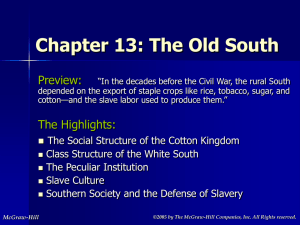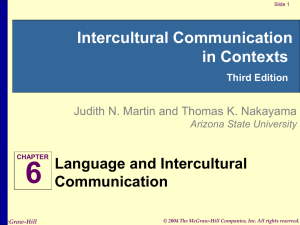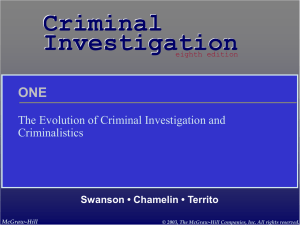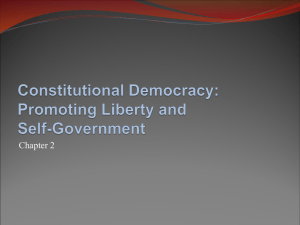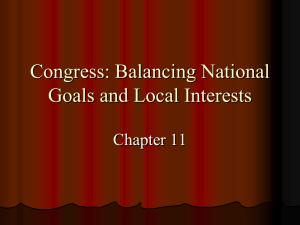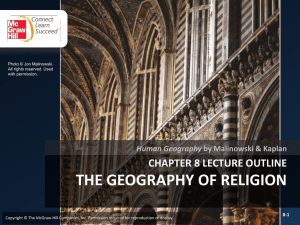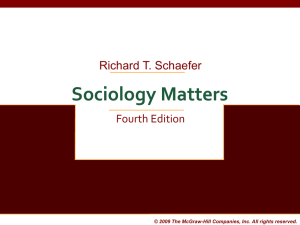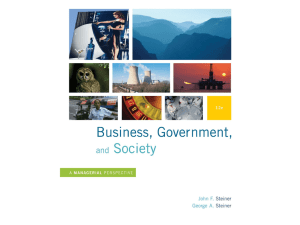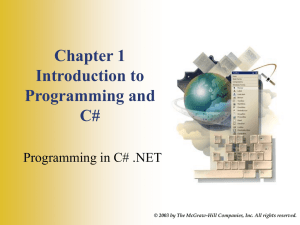9. State, Society and the Quest for Salvation in India
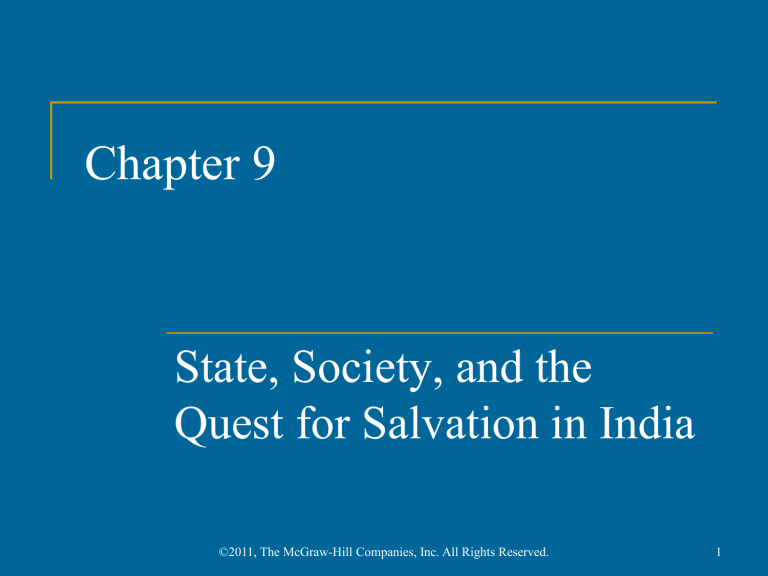
Chapter 9
State, Society, and the
Quest for Salvation in India
©2011, The McGraw-Hill Companies, Inc. All Rights Reserved.
1
The Mauryan and Gupta Empires
321 B.C.E.-550 C.E.
©2011, The McGraw-Hill Companies, Inc. All Rights Reserved.
2
India Before the Mauryan Dynasty
520 B.C.E., Persian emperor Darius conquers northwest India
Introduces Persian ruling pattern
327 B.C.E., Alexander of Macedon destroys
Persian empire in India
Troops mutiny, depart after two years
Political power vacuum
©2011, The McGraw-Hill Companies, Inc. All Rights Reserved.
3
Kingdom of Magadha
Most significant remaining kingdom after
Alexander’s departure
Central Ganges plain
Economic strength
Agriculture
Trade in Ganges valley, Bay of Bengal
Dominated surrounding regions in northeastern
India
©2011, The McGraw-Hill Companies, Inc. All Rights Reserved.
4
Chandragupta Maurya
Took advantage of power vacuum left by
Alexander
Overthrew Magadha rulers
Expanded kingdom to create first unified Indian empire
Mauryan dynasty
©2011, The McGraw-Hill Companies, Inc. All Rights Reserved.
5
Chandragupta’s Government
Advisor Kautalya
Recorded in Arthashastra , manual of political statecraft
Foreign policies, economics
Domestic policies
Network of spies
Legend: Chandragupta retires to become a monk, starves himself to death
©2011, The McGraw-Hill Companies, Inc. All Rights Reserved.
6
Ashoka Maurya
Grandson of Chandragupta
Represents high point of Mauryan empire, r. 268-232 B.C.E.
Expanded empire to include all of Indian subcontinent except for south
Positive rulership integrated Indian society
Much better known as a ruler than conqueror
©2011, The McGraw-Hill Companies, Inc. All Rights Reserved.
7
Ashoka’s Edicts
Carved on to enormous rock pillars
Placed in commonly traveled areas including marketplaces and main roads
Proclaimed the laws of Ashoka
©2011, The McGraw-Hill Companies, Inc. All Rights Reserved.
8
Decline of the Mauryan Empire
Economic crisis follows death of Ashoka
High costs of bureaucracy, military not supported by tax revenue
Frequent devaluations of currency to pay salaries
Regions begin to abandon Mauryan empire
Disappears by 185 B.C.E.
©2011, The McGraw-Hill Companies, Inc. All Rights Reserved.
9
Regional Kingdom: Bactria
Northwestern India
Ruled by Greek-speaking descendants of
Alexander’s campaigns
Intense cultural activity accompanies active trade
©2011, The McGraw-Hill Companies, Inc. All Rights Reserved.
10
Regional Kingdom: Kush
Northern India/central Asia
Ca. 1-300 C.E.
Maintained silk road trade network
©2011, The McGraw-Hill Companies, Inc. All Rights Reserved.
11
The Gupta Dynasty
Based in Magadha
Founded by Chandra Gupta (no relation to
Chandragupta Maurya), ca. 320 C.E.
Slightly smaller than Mauryan empire
Highly decentralized leadership
Foundations for studies in natural sciences and mathematics
©2011, The McGraw-Hill Companies, Inc. All Rights Reserved.
12
Gupta Decline
Frequent invasions of White Huns, fifth century
C.E.
Gupta dynasty disintegrates along regional fault lines
Smaller local kingdoms dominate until Mughal empire founded in sixteenth century
©2011, The McGraw-Hill Companies, Inc. All Rights Reserved.
13
Economy: Towns and Manufacturing
Manufactured goods in big demand
Developed in dense network of small workshops
Trade intense, capitalizes on trade routes across
India
©2011, The McGraw-Hill Companies, Inc. All Rights Reserved.
14
Long-Distance Trade
Persian connection since Cyrus, Darius
Massive road-building projects under Persian rule
Alexander extends trade west to Macedon
Trade routes through Kush mountains, the silk roads
©2011, The McGraw-Hill Companies, Inc. All Rights Reserved.
15
Trade in the Indian Ocean Basin
Seasonal sea trade expands
Spring/winter winds blow from southwest, fall/winter winds blow from northwest
Trade from Asia to Persian Gulf and Red Sea,
Mediterranean
©2011, The McGraw-Hill Companies, Inc. All Rights Reserved.
16
Society: Gender Relations
Patriarchy entrenched
Child marriage common (eight-year-old girls married to men in twenties)
Women encouraged to remain in private sphere
©2011, The McGraw-Hill Companies, Inc. All Rights Reserved.
17
Social Order
Caste system from Aryan times
Brahmins (priests)
Kshatriyas (warriors, aristocrats)
Vaishyas (peasants, merchants)
Shudras (serfs)
©2011, The McGraw-Hill Companies, Inc. All Rights Reserved.
18
Castes and Guilds
Increasing economic diversification challenges simplistic caste system
Jati formed: guilds that acted as subcastes
Enforced social order
“Out-castes” forced into low-status employment
©2011, The McGraw-Hill Companies, Inc. All Rights Reserved.
19
Wealth and the Social Order
Upward social mobility possible for vaishyas, shudras
Wealth challenges varna for status
©2011, The McGraw-Hill Companies, Inc. All Rights Reserved.
20
Religions of Salvation in Classical
India
Social change generated resentment of caste privilege
e.g. brahmins free from taxation
Sixth-fifth century B.C.E., new religions and philosophies challenge status quo
Charvakas: atheists
Jainists, Buddhists, Hindus
©2011, The McGraw-Hill Companies, Inc. All Rights Reserved.
21
Jainism
Vardhamana Mahavira, 540-468 B.C.E.
Abandons privileged family to lead ascetic life
Promotes seventh century movement based on
Upanishads
Emphasis on selfless living, concern for all beings
©2011, The McGraw-Hill Companies, Inc. All Rights Reserved.
22
Ahimsa
Principle of extreme nonviolence
Jainists sweep earth, strain water, use slow movements to avoid killing insects
Ahimsa continues to inspire modern movements
(Gandhi, Martin Luther King Jr.)
©2011, The McGraw-Hill Companies, Inc. All Rights Reserved.
23
Appeal of Jainism
Rejected caste, jati distinctions
Obvious appeal to underprivileged groups
But asceticism too extreme to become a mass movement
©2011, The McGraw-Hill Companies, Inc. All Rights Reserved.
24
Early Buddhism
Siddhartha Gautama, ca. 563-483 B.C.E.
Encountered age, sickness, death, then monastic life
Abandoned comfortable life to become a monk
©2011, The McGraw-Hill Companies, Inc. All Rights Reserved.
25
Gautama’s Search for Enlightenment
Intense meditation, extreme asceticism
Forty-nine days of meditation under bo tree to finally achieve enlightenment
Attained title of Buddha
: “the enlightened one”
©2011, The McGraw-Hill Companies, Inc. All Rights Reserved.
26
The Buddha and His Followers
Begins teaching new doctrine ca. 528 B.C.E.
Followers owned only robes, food bowls
Life of wandering, begging, meditation
Establishment of monastic communities
©2011, The McGraw-Hill Companies, Inc. All Rights Reserved.
27
Buddha and His Disciples
©2011, The McGraw-Hill Companies, Inc. All Rights Reserved.
28
Buddhist Doctrine: The Dharma
The Four Noble Truths
All life is suffering
There is an end to suffering
Removing desire removes suffering
This may be done through the eight-fold path
Right views, intention, speech, action, livelihood, effort, mindfulness, concentration
©2011, The McGraw-Hill Companies, Inc. All Rights Reserved.
29
Appeal of Buddhism
Less dependence on brahmins for ritual activities
No recognition of caste, jati status
Philosophy of moderate consumption
Public service through lay teaching
Use of vernacular, not Sanskrit
Monasteries become important institutions in
Indian society
©2011, The McGraw-Hill Companies, Inc. All Rights Reserved.
30
A Buddhist Monastery
©2011, The McGraw-Hill Companies, Inc. All Rights Reserved.
31
Ashoka’s Support of Buddhism
Personal conversion to Buddhism
Saddened after violent war with Kalinga
Banned animal sacrifices, mandated vegetarianism in court
Material support for Buddhist institutions, missionary activities
©2011, The McGraw-Hill Companies, Inc. All Rights Reserved.
32
Changes in Buddhist Thought
Third century B.C.E. to first century C.E.
Buddha considered divine
Institution of boddhisatvas
(“saints”)
Charitable donations to monasteries regarded as pious activity
©2011, The McGraw-Hill Companies, Inc. All Rights Reserved.
33
Spread of Mahayana Buddhism
Mahayana (“greater vehicle”), newer development
India, China, Japan, Korea, central Asia
Hinayana (“lesser vehicle,” also Theravada), earlier version
Ceylon, Burma, Thailand
©2011, The McGraw-Hill Companies, Inc. All Rights Reserved.
34
Nalanda
Buddhist monastery
Quasi-university: Buddhism, Hindu texts, philosophy, astronomy, medicine
Peak at end of Gupta dynasty
Helped spread Indian thought
e.g. mathematical number zero
©2011, The McGraw-Hill Companies, Inc. All Rights Reserved.
35
Emergence of Popular Hinduism
Composition of epics from older oral traditions
Mahabharata
Ramayana
Emphasis on god Vishnu and his incarnations
©2011, The McGraw-Hill Companies, Inc. All Rights Reserved.
36
The Bhagavad Gita
“Song of the lord”
Centuries of revisions, final form ca. 400 C.E.
Dialogue between Arjuna and Krishna during civil war
©2011, The McGraw-Hill Companies, Inc. All Rights Reserved.
37
Hindu Ethics
Obedience to religious and moral laws ( dharma)
Pursuit of economic well-being and honesty
( artha)
Enjoyment of social, physical, and sexual pleasure ( kama )
Salvation of the soul ( moksha )
©2011, The McGraw-Hill Companies, Inc. All Rights Reserved.
38
Popularity of Hinduism
Gradually replaced Buddhism in India
Gupta dynastic leaders extend considerable support
©2011, The McGraw-Hill Companies, Inc. All Rights Reserved.
39



